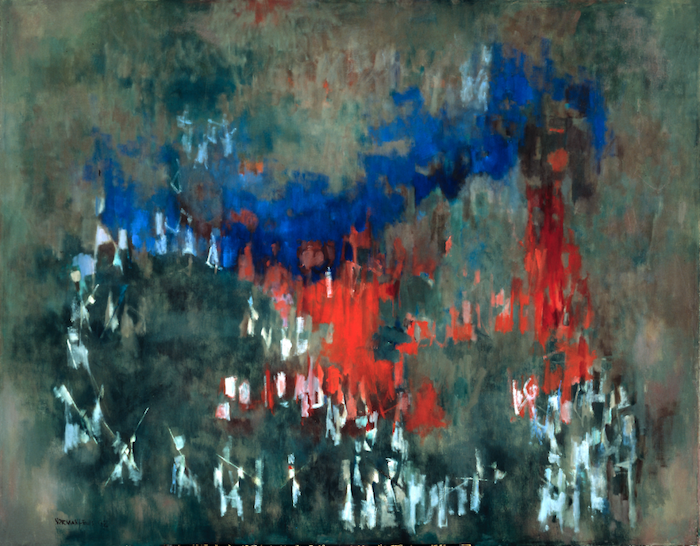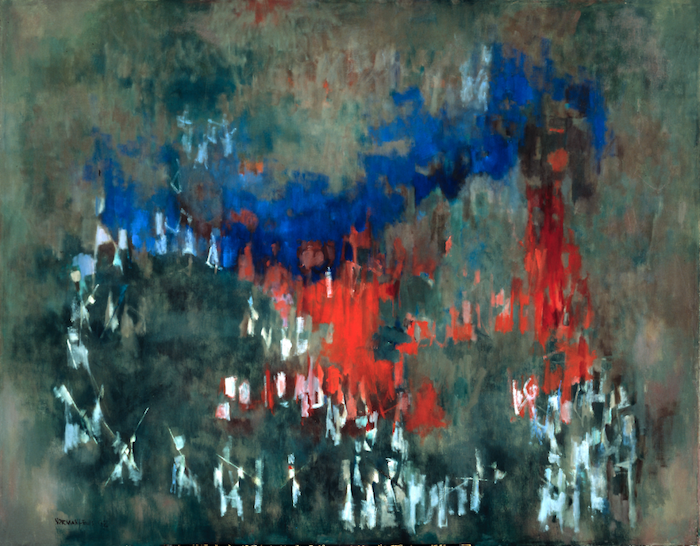Norman Lewis’ Evening Rendezvous
Artist Norman Lewis often claimed that art could not help solve society’s problems, but Evening Rendezvous is a painting making a strong social commentary.
The small white marks emerging from gray twilight resemble hooded figures, gathered around a bonfire suggested by the hot reds at the center of the image. Angular white shapes in the foreground describe men closest to the headlights of their cars, while those at the top are obscured by billowing blue smoke. The gray-green muted background mimics darkness partially lit by flickering firelight. (1)
This abstract painting with its humanlike figures and vivid color evokes an evening gathering of the Ku Klux Klan, and the combination of red, white, and blue mocks the patriotism that the Klan claimed as its defense. In Evening Rendezvous, Lewis’ conveys the fear and sorrow caused by the Klan. (2)

In the 1930s, Lewis began his artistic career as a social realist, depicting problems faced by working class Americans, bread lines, evictions and police brutality in an overtly figural manner. (3) During World War II, he served as a ship fitter and experienced prejudice and discrimination, which made him question whether his style and subject matter reflected the experience of black Americans, and he became determined to battle racism and social injustice. (4)
During the mid-1940s, Lewis abandoned the social realist style, having decided that painting “an illustrative statement that merely mirrors some of the social conditions” was not an effective agent for change. Around 1946, he began exploring an overall, gestural approach to abstraction that established him as the only African American among the first generation of Abstract Expressionist artists. (5)
It’s worth noting that New York Art critics during the 1950s and 1960s were adamant that painting be nothing but about painting, and artists who disagreed typically risked bad press and lost sales. This environment could have influenced Lewis to state that his art only expressed his personal feelings and vision. Nonetheless, Lewis demonstrated he was deeply troubled by the African American struggle for civil rights with a work that resonates because of the structural inequities and racial injustices African Americans are still battling 58 years later. (6)
Lewis’ Evening Rendezvous and over 40 more artworks by 34 African American artists are featured in African American Art in the 20th Century, a traveling exhibition organized by Smithsonian American Art Museum, at The Westmoreland.
.
Bibliography:
1. Mecklenburg, Virginia, “Commentaries on the Artworks: Norman Lewis” in Richard J. Powell et al, African American Art: Harlem Renaissance, Civil Rights Era, and Beyond, (New York, NY: Smithsonian American Art Museum and Skira Rizzoli Publications, Inc., 2012) 165–167.
2. Ibid, 165.
3. Norman Lewis Artist Biography – Data Source: Smithsonian American Art Museum
Norman Lewis
Norman Lewis
4. Mecklenburg, Virginia, “Commentaries on the Artworks: Norman Lewis” in Richard J. Powell et al, African American Art: Harlem Renaissance, Civil Rights Era, and Beyond, (New York, NY: Smithsonian American Art Museum and Skira Rizzoli Publications, Inc., 2012) 167.
5. Excerpt from the African American Art in the 20th Century Exhibition Label, a traveling exhibition organized by Smithsonian American Art Museum.
6. Mecklenburg, Virginia, “Commentaries on the Artworks: Norman Lewis” in Richard J. Powell et al, African American Art: Harlem Renaissance, Civil Rights Era, and Beyond, (New York, NY: Smithsonian American Art Museum and Skira Rizzoli Publications, Inc., 2012) 167.
